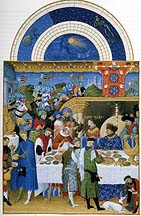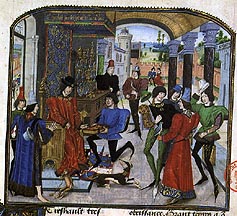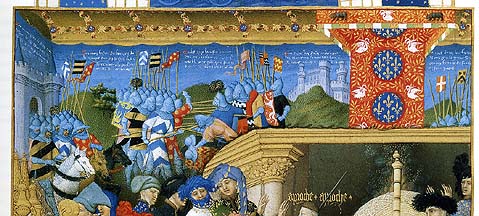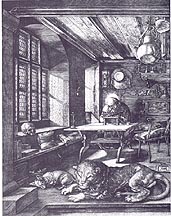Art Home | ARTH Courses | ARTH 214 Assignments
History of Northern Renaissance Art:
Introduction
January page from the Très riches heures (large image)
This miniature is a fitting introduction to a course on the history of Northern Renaissance art. It is the illustration that introduces the month of January in the calendar of the Très riches heures. This manuscript is a Book of Hours, a popular devotional book among the laity in the later Middle Ages. It was made for the most important patron in France at the beginning of the fifteenth century, John the Duke of Berry. The original miniatures in the Très riches heures were painted by the most innovative miniaturists of the period, a group of brothers known as the Limbourg Brothers who were court artists for the Duke of Berry.
In 1974,
Millard Meiss published his The Limbourgs and Their Contemporaries which
was the third and last part of his French Painting in the Time of Jean
de Berry. For Meiss the miniatures the Limbourgs painted in the Très
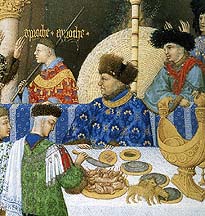 riches
heures were the culmination of French manuscript illumination
of the early fifteenth century. Meiss, who began his career studying Italian
panel fourteenth century painting, approached the study of the work of
the Limbourgs from the methodological perspectives developed to study early
Italian Renaissance painting. Meiss placed a heavy emphasis on stylistic
analysis observing the significant pictorial innovations. The
miniature's "naturalism" with details like the courtiers warming
themselves by the
fire and attention to details like the golden nef (nef=
boat) decorated
with the ducal emblems of the bear and swan and like the manner
in which the tapestry is hung from the back wall attract Meiss's attention.
Notable also is the careful delineation of Jean de Berry's physiogomy.
Gone here is the generic representation of individuals characteristic
of medieval art.
riches
heures were the culmination of French manuscript illumination
of the early fifteenth century. Meiss, who began his career studying Italian
panel fourteenth century painting, approached the study of the work of
the Limbourgs from the methodological perspectives developed to study early
Italian Renaissance painting. Meiss placed a heavy emphasis on stylistic
analysis observing the significant pictorial innovations. The
miniature's "naturalism" with details like the courtiers warming
themselves by the
fire and attention to details like the golden nef (nef=
boat) decorated
with the ducal emblems of the bear and swan and like the manner
in which the tapestry is hung from the back wall attract Meiss's attention.
Notable also is the careful delineation of Jean de Berry's physiogomy.
Gone here is the generic representation of individuals characteristic
of medieval art.
For twentieth century scholars, who had inherited the art historical tradition derived from Vasari's Lives, a sixteenth century collection of biographies of artists, one of the central questions in the study of Italian panel painting was the identification of individual artists. Meiss took this perspective and sought to identify in the miniatures of the Très riches heures the contributions and personalities of the individual brothers. Noting parallels to motifs and conventions in Italian art, Meiss was also careful to place the miniatures within the iconographical tradition of images of Labor of the Months that can be traced back to Antiquity.
Immediate critics of Meiss's work drew attention to his biases learned from study of Italian painting. Scholars like L.M.J. Delaissé were concerned with the way Meiss treated the miniatures in manuscripts like panel paintings. Meiss was not alone with this bias. Erwin Panofsky in his seminal study of Northern Renaissance art --Early Netherlandish Painting-- treated fifteenth century Parisian miniature painting as the prelude to the Netherlandish painters like Robert Campin, Jan Van Eyck, and Rogier van der Weyden. By treating the miniatures in fifteenth century books like panel paintings, scholars like Meiss and Panofsky lost sight of the relationship of the miniatures to the books they appeared in. Delaissé developed the methodology that he dubbed codicology which sought to examine manuscripts as a totality. Manuscripts were the product of the collaboration of distinct specialists. A trained scribe would write the text, then an illuminator would add the text and border decoration, then the miniatures would be painted, and the manuscript would then be bound. This type of collaborative process raises significant questions: who was responsible for overseeing the project? What would be the relationship of the different specialists? Did they work in the same workshop, or were they independent craftsmen?
Meiss's emphasis on the "realism" of the miniatures in the Très riches heures has been significantly tempered by more recent scholars. Jonathan Alexander has emphasized that the miniatures should not be seen as transparent windows into the fifteenth century, but rather the calendar images should be understood as constructions based on the codes and conventions of the princely culture of the early fifteenth century. In looking at a page like the January page, we need to consider the cultural significance of the New Year's Feast for the nobility of the early fifteenth century. Brigitte Buettner's study of this feast that the French knew as étrennes gives us important insights into the political and social implications of gift giving associated with the feast. The étrennes practice of gift giving confirmed membership in the court of a prince. The relationship between prince and vassal was a mutual and personal one. Just as a courtier's identity and social status was defined by whose court he belonged to, so to was the magnificence of the prince reflected in the size and quality of his court. In the January page miniature, next to Jean de Berry appears a steward holding a staff with the words "Aproche, Aproche" or "Approach, approach" inscribed above his head. Again the social practices of the period help to explain the significance of this detail. The closer a courtier was to the physical body of the prince the higher his status was. Intimacy and familiarity were important signs of a courtier's relative importance. A thesis I want to develop during the course is that the development of individualized portraiture evident in this miniature can be explained by these social codes of familiarity and intimacy.
Feminist scholars have drawn attention to the importance of exploring gender construction and roles in different periods. When we discuss the calendar of the Très riches heures later this semester, this will be an important perspective. But it is an important consideration in the January page as well. Here what is significant is the absence of women with one possible exception. This reflects the clear divisions in gender that articulated court spaces. The king and queen occupied different floors in the fourteenth century Louvre. This absence of women articulates the étrennes feast as being a dominantly male celebration.
Social historians have emphasized the importance of considering social class and economic status. We will become aware of the clear social structure articulated in the Très riches heures calendar images. It is significant that the social construction presented here reflects an earlier Medieval social structure where society was divided into three categories: those who fight (nobility), those who pray (clergy), and those who work (peasant class). It is significant that members of the increasingly powerful merchant class and the urban craftsmen are not represented in the calendar. The world represented in the Très riches heures reflects a world of the past when landownership was the basis of power. When these miniatures were being painted the world was already being transformed by the power of money. Our tendency to look at a miniature like the January page and wonder about the monetary costs of the different objects represented reflects the victory of capitalism and the power of money, but it is an anachronistic perspective in the context of court culture at the beginning of the fifteenth century. An important consideration in our study of Northern Renaissance art is to attempt to reconstruct the "period eye" and determine what are the assumptions and social codes at work in the creation of an image.
In the same vein, we need to be careful not to impose our assumptions about the nature of art on the material we consider. This is a mistake that both Meiss and Panofsky made. As we noted above, they approached the miniatures in the Très riches heures as being equivalent to panel painting. This was based on their bias to panel painting as the dominant media. A topic in our course will be the development of panel painting in Northern Renaissance art. Around 1400 panel painting did not have the status that it will have by the sixteenth century. The dominant media at the beginning of the fifteenth century were illuminated manuscript, metalwork, jewelry, and tapestries. In traditional art historical studies, the three latter media are not given serious attention. Tapestries, jewelry and metalwork have been relegated to the status of "Decorative Arts," and not given the same serious attention as painting and monumental sculpture. This designation reflects the assumptions and hierarchy of media that will develop during the Renaissance. While as noted above, manuscript illumination became a subject of modern scholarly attention because of its similarities to paintings, for the beginning of the fifteenth century manuscript illumination was regularly associated with tapestries, jewelry and metalwork. This is documented by inventories, by literary references, and by visual evidence. The fourteenth century poem by Eustache Deschamps describes a Book of Hours like a precious jewel:
An Hours of the Virgin must be
mine (Eustache Deschamps, Oeuvres, IX, pp. 44-46 (quoted in De Winter, Philippe le hardi, p. 328): Heures me fault de Nostre
Dame |
In his account of the presentation of his collected works of poetry to the king of England, Froissart emphasizes the king's admiration of the physical beauty of the manuscript:
| On the Sunday, the whole council were gone to London, excepting the duke of York, whom remained with the king, and sir Richard Sturry: these two, in conjunction with sir Thomas Percy, mentioned me again to the king, who desired to see the book I had brought for him. I presented it to him in his chamber, for I had it with me, and laid it on his bed. He opened and looked into it with much pleasure. He ought to have been pleased, for it was handsomely written and illuminated, and bound in crimson velvet, with ten silver-gilt studs, and roses of the same in the middle, with two large clasps of silver-gilt, richly worked with roses in the center. The king asked me what the book treated of: I replied, "Of love!" He was pleased with the answer, and dipped into several places, reading parts aloud, for he read and spoke French perfectly well, and then gave it to one of his knights, called sir Richard Credon, to carry to his oratory, and made me many acknowledgments for it. |
The presentation miniature of Vasco da Lucena presenting his translation of Quintus Curtius's biography of Alexander the Great to Charles the Bold probably very intentionally juxtaposes the book in the foreground with a table laden with rich metalwork in the background.
Material display played a central role in the political world of the courts of northern Europe at the end of the Middle Ages and early Renaissance. The magnificence and splendor of the court were signs of political and social status. Displays of magnificence were intended to give visible manifestation of the prince's authority and eminence to their subjects, allies, and rivals. An excerpt from a letter written in 1461 to the Duke of Milan describes a banquet at the court of Philip the Good, the duke of Burgundy:
| The banquet hall...was completely hung with tapestries of cloth of gold....Behind the dais where sat the princes were silken hangings and other adornments of gold. Opposite was a display of plate, very rich and all of vessels of gold and silver gilt, four unicorn horns arranged in order of size like organ pipes, and many vessels of crystal and of other precious stones. This plate remained untouched that day because so of it does the Duke have that there was plenty of additional plate for the dinner service.- Prospero da Camogli, letter to the duke of Milan, 9 May 1461 as quoted in Marina Belozerskaya, Rethinking the Renaissance: Burgundian Arts Across Europe, Cambridge, 2002, p. 76. |
This account could easily describe a feast at the court of Philip's great uncle, Jean de Berry. Like the Limbourg Brothers in the January page of the Très riches heures, the observer at the Burgundian court calls attention to the magnificence of the decoration. Special attention is directed in both to the "tapestries of cloths of gold" and the "silken hangings" as well as the "display[s] of plate" and "vessels of gold and silver gilt."
Where modern critics like Meiss and Panofsky put a priority on the "realistic" details of the miniature as evidence of the inscreasing naturalism of art of the period, the contemporary viewer would have focused on the splendor of the objects represented in the miniature. The rich colors especially the ultramarine blue and gold were seen as clear symbols of status. The blue used here would need to have been ground from a semi-precious stone known as lapis lazuli that would need to have been imported from the orient. The contemporary viewer would have clearly been aware of the preciousness of the materials used in the creation of the miniature. It is not by chance that the dominant colors associated with Jean de Berry in the miniature are the blue of his gown and the gold of the firescreen that acts almost like a halo behind the duke. With its emphasis on display, court culture put a major emphasis on the quality of the fabric worn. The fine fabrics with embroideries of gold and silver threads were signs of social position. The modern expression "Clothing makes the man" had real meaning in court culture. The materials used to make the garments of a prince were considered to be noble. One wore the quality and style of fabric that were appropriate to one's station in life. Christine de Pizan was particularly attentive to this as evidenced by the following excerpt from her Livre des trois vertus:
| It is most seemly that any princess or land-owning lady, according to her station in life be richly adorned, as much by garments, dress, ornaments, and jewels, as by a great court with courtiers and much ceremony due to the honour of the position where God has placed her. But do not doubt for a moment that if you (or anyone else) are not content with such rank and clothing as your noble forebears have enjoyed and you want to have something greater or to make innovations, you are making a mistake and act against your honour and against the good of sobriety. ...(I, 10) |
A concern for Christine was the rising merchant class who with the financial resources gained through meeting the nobility's taste for fine things began to rival the nobility in their possessions. In a passage also from the Livre des trois vertus, Christine directly attacks the conspicuous display adopted by the newly rich merchant class which she sees as undermining the "best order (according to the ancient usages of France)", " the noblest realm in the world." Christine's description of the bed chamber of a merchant's wife would have been understood to be like that of a member of the highest noble order:
| In this chamber was a large, highly ornamented dresser covered with golden dishes. The bed was large and handsome and hung with exquisite curtains. On the floor around the bed carpets on which one walked were all worked with gold, and the large ornamented hangings, which extended more than a hand span below the bed-spread, were of such fine linen of Rheims that they were worth three hundred francs. On top of this bedspread of tissue of gold was another large covering of linen as fine as silk, all of one piece and without a seam (made by a method only recently invented) and very expensive; and it was said to be worth two hundred francs and more. It was so wide and long that it covered all sides of this large, elaborate bed and extended beyond the edge of the bedspread, which trailed on the floor on all sides. In this bed lay the woman who was going to give birth, dressed in in crimson silk cloth and propped up on big pillows of the same silk with big pearl buttons, adorned like a young lady. And God knows what money was wasted on amusements, bathing and various social gatherings, according to the customs in Paris for women in childbed (some more than others), at this lying-in! Although there are many example of great prodigality, this extravagance exceeds all others, and so is worth putting in a book! This thing was even reported in the queen's chamber! Some people will remark that the people of Paris have too much blood, and that the abundance of it sometimes brings on certain illnesses. In other words, a great abundance of riches can easily lead them astray. It would be better for them if the king imposed some aide, impost or tax on them to prevent their wives from going about comparing themselves with the queen of France, who scarcely looks any grander. (III,3) |
Notice how Christine calls attention to many of the same details the Limbourgs emphasize in the January page of the Très riches heures. The social tensions evident in this passage between the traditional nobility whose position in society was dependent on birth and the amount of land-holdings and the new merchant class who were establishing themselves as important members of court through their financial acumen will be an important theme in this course. The rise of panel painting in the work of artists like Robert Campin (the Master of Flémalle) and Jan van Eyck will be seen in relationship to the social position of their patrons. This is a different world than the one represented by the Limbourgs who, like Christine, appeal to the "best order (according to the ancient usages of France)", " the noblest realm in the world."
Court
culture revolved around feasts like 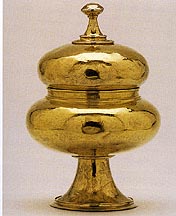 the étrennes feast
represented in the January page. A feast like this elevates a meal to the
status of
a public ceremony validating the political and social order. Compare
the January page to the following description of the court of Charles V
presented in her biography of Charles V ( Le livre des fais et bonnes
moeurs du sage roy Charles V):
the étrennes feast
represented in the January page. A feast like this elevates a meal to the
status of
a public ceremony validating the political and social order. Compare
the January page to the following description of the court of Charles V
presented in her biography of Charles V ( Le livre des fais et bonnes
moeurs du sage roy Charles V):
| Thus this king, empowered by the world....knew well how to receive nobility, members of the bourgeoisie, and peasants, and extended his courtesy to noble princes and their messengers, when they came to dine, and, according to their nobility, sat at his table. And at these dinners, when high princes were present, and likewise at solemn ceremonies, it was certainly a magnificent things for all people to see: the tableware, the trappings, the noble decorations consisting of gold and silk tapestries worked in fine warp that were hung along these walls in rich chambers (les nobles paremens d'or et de soye ouvrez de haulte lice, qui tendus estoient par ces parois et ces richs chambres), and of velvets embroidered with large pearls, and with gold and silk, with various strange emblems, the ornaments everywhere, hing with these golden draperies, tents, and heavens hanging over these high tables and curtained chairs. |
All the
objects represented in Christine's description and the
miniature would have been read as statements of the magnificence of the
respective court. The magnificence of the gold and silver gilt work
shown on the sideboard would have been assessed.  For example the courtier
in blue in the left foreground holds a cup that can be identified as an hanap.
For example the courtier
in blue in the left foreground holds a cup that can be identified as an hanap.
 This goblet would be especially associated with formal state occasions.
It is like one that bears the devices of Jean's nephew, John the
Fearless the Duke of Burgundy. This personalization of the cup would make
it an effective object of gift exchange, confirming the political and social
relationships of the parties.
This goblet would be especially associated with formal state occasions.
It is like one that bears the devices of Jean's nephew, John the
Fearless the Duke of Burgundy. This personalization of the cup would make
it an effective object of gift exchange, confirming the political and social
relationships of the parties.
The tapestries on the back wall further set the stage for this feast. A cloth of honor in red fabric with gold decoration and the arms and devices of the Duke identifies Jean de Berry's place at the table. The tapestry on the back wall that illustrates what appears to be a battle of medieval knights has been identified as a representation of the Homeric story of the Battle of Troy. Although few tapestries from the period have come down to us, literary references and inventories make it clear that tapestries played a very important role in court life. Not only did they provide warmth and color to the interiors of a drafty, stone palaces, but they also served as theatrical backdrops to court celebrations. A dramatic example of this is presented by the accounts of the entry into Paris in 1461 of Philip the Good, the duke of Burgundy, and the newly crowned Charles VII, king of France. Philip ordered the facade of his residence in Paris, the Hôtel d'Artois to be covered with two tapestries series: the History of Gideon and the Life of Alexander the Great. A contemporary account emphasizes the powerful impact this display had on the Parisian audience:
| The people of Paris, of all ranks,...., from morning until night, came and went in great multitudes as if in a procession, [and] not for just one or two days, but incessantly day after day as long as the duke resided in Paris. Among these riches there were two things that were shown publicly and that [the Parisians] were able to neither to recover from nor to get enough of. The first was the tapestry of Gideon, the richest on the earth at this time and [richer] than all the others of the world in the past. It surpasses [these] as much in richness as by its work. And [it is] so large that scarcely any hall in the world is able to contain it all [Chastellain, Oeuvres, vol. 3, pp. 159-160, as quoted and translated in Jeffrey Chipps Smith, "Portable Propaganda- Tapestries as Princely Metaphors at the Courts of Philip the Good and Charles the Bold," The Art Journal, 1989, p. 125] |
Review of inventories of tapestry collections like that of Jean's brother, Philip the Bold, demonstrates very defined categories of subject matter. As one might expect a good number were of religious subjects illustrating important events in the life of Christ and the Virgin or representing the lives of saints that were particularly important to the patron. These tapestries could be used to decorate the court on the appropriate feast day following the liturgical calendar. Other tapestries deal with the theme of courtly love and romances. Heroic themes were a third major category. These scenes could relate back to ancient legend and history. Themes of the story of Trojan War were particularly popular. This choice can be explained by the belief that the French royal family could trace its ancestry back to the family of great Trojan prince, Hector. Tapestries illustrating the life of Alexander the Great were also very popular. The Macedonian king was a very important model for the ideal ruler. Tapestries illustrating the exploits of great medieval warriors were also popular. Many of these are set in the Carolingian period. Again the fifteenth century prince would regularly assert his ancestral links to Charlemagne and his famous followers. Together these heroic themes focus on the central social identity of the nobility as those who fight. Thus the inclusion of the Trojan War tapestry in the January miniature is very appropriate for the étrennes feast that articulates the political and social alliances of the nobility.
To get a sense of the dramatic change that will occur in European art from the beginning of the fifteenth century to the beginning of the sixteenth century, it is useful to compare the Limbourgs' January page to Albrecht Dürer's famous engraving of St. Jerome in his Study:
While the traditional approaches of scholars like Meiss and Panofsky would tend to see both works as important examples of the increasing concerns with rendering space, light, and details in an illusionistic manner, these works can be seen to be on either sides of a fault line marking the profound social, economic, and artistic changes that marked the Northern Renaissance. Consider, for example, the social position of the artists and the audience these works were made for. The Limbourgs' status in the early fifteenth-century was directly connected to their position as members of the court of Jean de Berry. As we will see, Albrecht Dürer resisted becoming a "parasite" as he would consider a court artist, and he worked to achieve his social and economic independence. In creating the Très riches heures, the Limbourgs were producing a work for a specific individual, Jean de Berry. The vision of reality presented in the Très riches heures, as we have begun to argue above, is that of their patron. In marked contrast, Dürer in developing printmaking as an artistic medium created his works for a market and not for an individual. We will see how he will develop his woodcuts for a more popular audience who are more intensely spiritual while his engravings were made for a more intellectual audience engaged in Humanist culture. St. Jerome as a Biblical scholar was the model for the Christian Humanists like Erasmus of Rotterdam.
Bibliography
Jonathan Alexander, "Labeur and Paresse: Ideological Representations of Medieval Peasant Labor," Art Bulletin, 72, 1990, pp. 436-452.
Brigitte Buettner, "Past Presents: New Year's Gifts at the Valois Courts, ca. 1400," Art Bulletin, 83, 2001, pp. 598-625.
